Driven by regulatory changes, 2025 could become the "ChatGPT moment" for blockchain applications in the financial and public sectors.
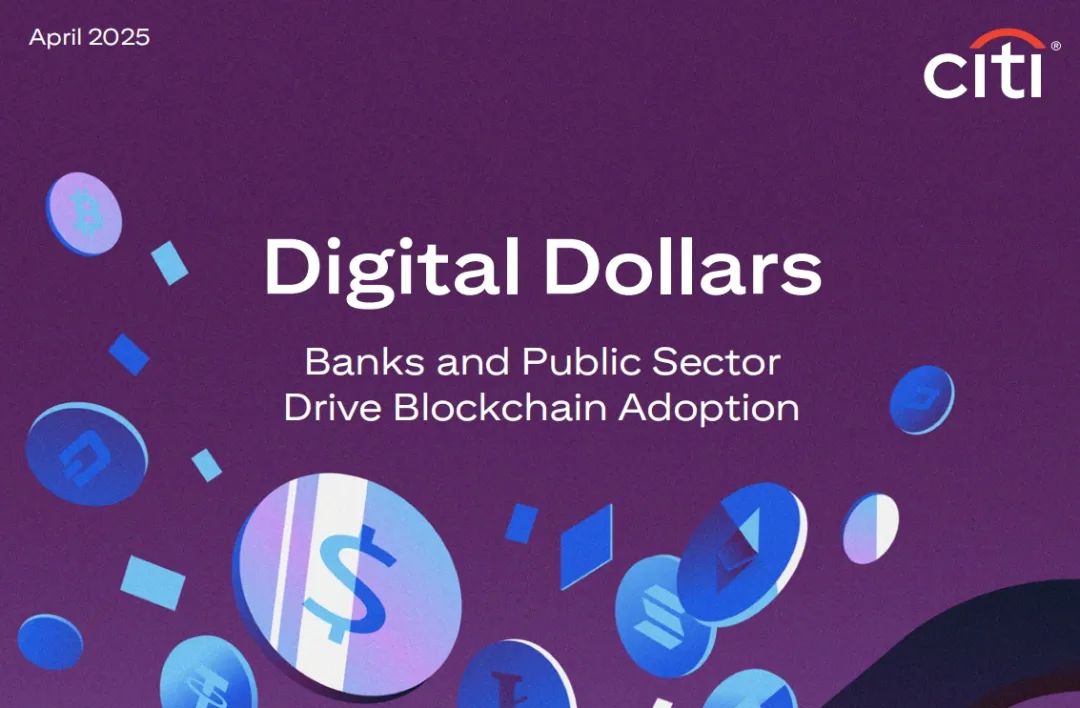
The origins of public blockchain networks can be traced back to the release of the Bitcoin white paper in 2008 and the birth of the genesis block in 2009. However, the conceptual foundations of blockchain have actually been gradually built over the decades since the 1970s. Nevertheless, so far, the application scope of blockchain in the financial and public sectors remains relatively limited.
The open-source and decentralized characteristics of blockchain are rooted in a core idea that mathematics and code can ensure privacy and freedom. From its cypherpunk origins, blockchain is not just a technological innovation; it also carries a strong political connotation, essentially representing an anti-establishment philosophy that opposes existing institutions, whether banks or governments. Cypherpunks are a group of advocates who promote the use of cryptographic and privacy-enhancing technologies to drive social and political change.
Public key cryptography first emerged in the mid-1970s, while hash functions and Merkle trees were born in the late 1970s. Meanwhile, the development of the modern internet is also noteworthy. In the 1980s, Arpanet began adopting the TCP/IP protocol, and by the early 1990s, the World Wide Web was officially born. However, during the booming development of the internet in the 1990s, the important element of "Digital Money" was notably absent.
The Bitcoin white paper released in 2008 proposed the establishment of a "peer-to-peer electronic cash system," a concept that gradually gained traction in the following years, leading to a significant increase in Bitcoin usage. As of April 2025, Bitcoin remains one of the dominant cryptocurrencies in the crypto ecosystem, with a market share of up to 64%.
Entering the 2020s, the narrative surrounding blockchain has undergone an almost 180-degree shift. What was once an anti-establishment movement has gradually moved into the mainstream. Between 2023 and 2024, "Real World Asset Tokenization (RWA)" became one of the dominant narratives in the crypto ecosystem. By the end of March 2025, one of the largest holders of Bitcoin was a U.S. Bitcoin ETF fund. Additionally, other U.S. institutions, including the U.S. government, ranked among the top ten holders of Bitcoin. In 2025, just days before the inauguration of the 47th President of the United States, the $TRUMP meme coin was launched on the Solana blockchain.
Stablecoins, as a type of digital currency based on blockchain networks, have enormous development potential. In recent years, the usage of stablecoins has shown a rapid growth trend. It is expected that between 2025 and 2030, with increasing regulatory transparency (especially in the U.S.), the usage of stablecoins may further increase significantly.
Moreover, public chains can bring higher transparency and enhanced trust. Whether in wealthy or poor countries, public institutions are striving to improve their trust index, and the characteristics of public chains are precisely what they urgently need. The adoption of blockchain is evolving alongside regulatory developments and the ongoing push for transparency and accountability.
Reflecting on the history of blockchain in 2025, how should we look forward to the future of stablecoins and blockchain? Citigroup GPS's latest research report, "Digital Dollars—Banks and Public Sector Drive Blockchain Adoption," may provide some answers, focusing on two key areas: new financial instruments (such as stablecoins) and the modernization of legacy systems.
Therefore, we have conducted a detailed compilation of this report, which offers valuable insights into the stablecoin GPT moment.
Coincidentally, two years ago during May Day, we also compiled Citigroup GPS's "Money, Tokens, and Games (Blockchain's Next Billion Users and Trillions in Value)," which had the subtitle Blockchain's Next Billion Users and Trillions in Value.
In the 2023 report, Citigroup predicted that by 2030, Billion Users would come from: currency, social, and gaming. Looking back from 2025, aside from the fleeting moments of SocialFi and GameFi, this gap will be filled by users holding cryptocurrencies or stablecoins, which is also the origin of Citigroup's 2025 stablecoin research report.
The full text is 18,000 words; enjoy the following:
Key Takeaways
Driven by regulatory changes, 2025 could become the "ChatGPT moment" for blockchain applications in the financial and public sectors.
By 2030, the total circulating supply of stablecoins could grow to $1.6 trillion in our expected baseline scenario, and to $3.7 trillion in our optimistic scenario. Even so, if challenges in application and integration persist, this figure could be close to $500 billion.
We expect that the supply of stablecoins will still be dollar-denominated (about 90%), rather than central bank digital currencies (CBDCs) promoting their national currencies.
The regulatory framework for stablecoins in the U.S. may drive net new demand for U.S. Treasury securities, making stablecoin issuers one of the largest holders of U.S. Treasuries by 2030.
Stablecoins pose a certain threat to the traditional banking ecosystem by replacing deposits. However, they may also provide new service opportunities for banks/financial institutions.
The public sector's application of blockchain is also increasingly gaining attention, thanks to the ongoing focus on transparency and accountability in public spending, as reflected in the U.S. government's DOGE (Department of Government Efficiency) initiative and various central banks and multilateral development banks' blockchain pilot projects.
Major use cases for public sector blockchain include: expenditure tracking, subsidy distribution, public record management, humanitarian aid activities, asset tokenization, and digital identity.
Although the on-chain transaction volume in the public sector may initially be small and the risks remain high, the increasing interest from the public sector could be an important signal for the broader application of blockchain.

I. Why is the large-scale adoption of blockchain happening now?

Why is 2025 likely to become the "ChatGPT moment" for blockchain applications in the financial and public sectors?
U.S. regulatory agencies' supportive stance on blockchain is expected to become a year of changing the industry landscape. This could lead to broader adoption of blockchain-based currencies and stimulate the emergence of other use cases in the U.S. private and public sectors in finance and other areas.
Another potential catalyst is the ongoing focus on transparency and accountability in public spending.
These changes are built on developments over the past 12-15 months, including the EU's Markets in Crypto-Assets (MiCA) regulation, the growth in user demand reflected in cryptocurrency ETF issuances, the institutionalization of cryptocurrency trading and custody, and the U.S. government's establishment of a strategic Bitcoin reserve.
While banks, asset management companies, public sectors, and government agencies have increased their engagement with blockchain, they still lag behind some more optimistic expectations. The reality is that digital finance already exists in consumer and institutional finance, built on proprietary databases and centralized systems like internet banking. We are now witnessing the accelerated convergence of internet-native technologies, currencies, and blockchain and digital-native use cases.
Government adoption of blockchain can be divided into two categories: empowering new financial tools and modernizing systems. Systems are upgraded through the integration of shared ledgers to enhance data synchronization, transparency, and efficiency.
Stablecoins are currently major holders of U.S. Treasuries and are beginning to influence global financial flows. The increasing popularity of stablecoins reflects the ongoing demand for dollar-denominated assets.
Artem Korenyuk, Digital Assets – Client, Citi
1.1 Stablecoins are on the rise
Stablecoins are cryptocurrencies pegged to stable assets (such as the dollar), and the main catalyst for their broader acceptance may be the clarity of U.S. regulation. This can better integrate stablecoins and blockchain (from a broader perspective) into the existing financial system.
Given the dollar's dominant position in international finance, changes in the U.S. regarding stablecoins will impact the broader global system.
The U.S. government seems keen to promote the development of the onshore digital asset industry, which is one of its focuses on enhancing innovation and efficiency. In January 2025, an executive order from the U.S. President titled "Strengthening America's Leadership in Digital Financial Technology" established a digital asset working group responsible for developing a federal regulatory framework for the industry.
In a regulatory-friendly context, digital assets are increasingly integrating with existing financial institutions, laying the groundwork for the growth of stablecoin usage, while macroeconomic factors such as emerging markets and frontier markets' demand for dollars further support this trend.
According to DefiLlama data, as of the end of March 2025, the total value of stablecoins exceeded $230 billion, which is 30 times that of five years ago. This partly reflects the growth in the total value of cryptocurrencies (which increased by 1400% over the five years ending in March 2025) and the growth in institutional demand. Our analysis indicates that in the baseline scenario, the total supply of stablecoins could reach $1.6 trillion, with bear and bull market scenarios reaching approximately $0.5 trillion to $3.7 trillion, respectively.
Demand for U.S. Treasuries: Establishing a regulatory framework for U.S. stablecoins will support the demand for risk-free dollar-denominated assets both domestically and internationally. Stablecoin issuers must purchase U.S. Treasuries or similar low-risk assets as a measure of their possession of safe underlying collateral. In the baseline scenario, we expect the amount of U.S. Treasuries purchased to exceed $1 trillion. By 2030, the amount of U.S. Treasuries held by stablecoin issuers may surpass the total amount held by any current jurisdiction.
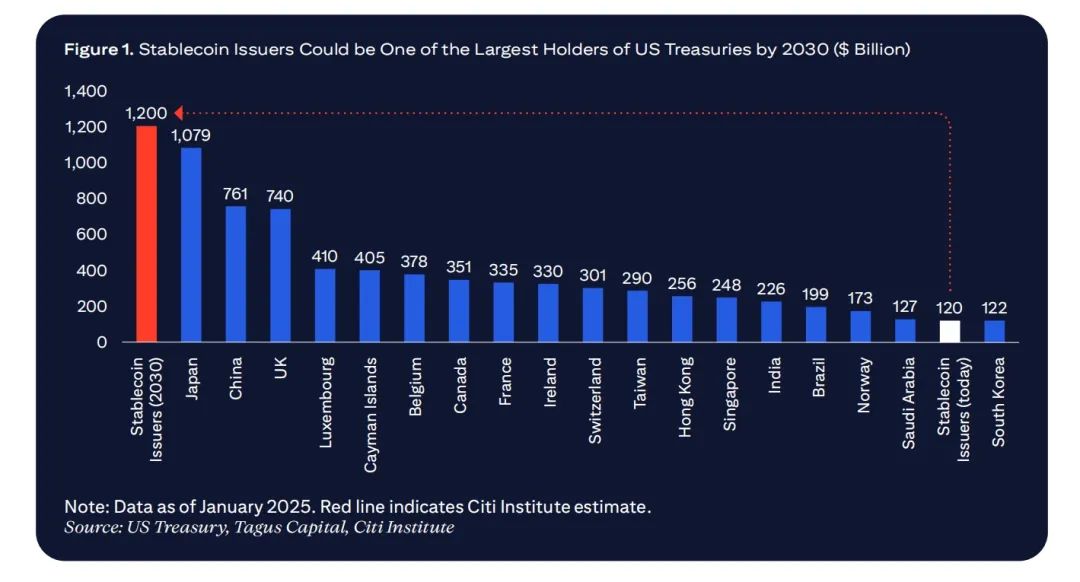
1.2 Future Challenges
The development of stablecoins also faces resistance and challenges. While the dominance of the dollar may evolve over time, with the euro or other currencies being driven by national regulations, many non-U.S. policymakers may view stablecoins as tools of dollar hegemony.
The goal of blockchain is to align the flow of currency with the speed of the internet and global commerce. Stablecoins can become a key tool in achieving this goal. The first step is clarity in legislation and regulation. Additionally, legal safeguards are needed.
Ryan Rugg, Digital Assets – Services, Citi
The geopolitical situation remains turbulent. If the world continues to move towards a multipolar system, policymakers in China and Europe are likely to be keen on promoting central bank digital currencies (CBDCs) or stablecoins issued in their national currencies. Policymakers in emerging and frontier markets will also remain vigilant about the local risks posed by dollarization.
Both stablecoins and central bank digital currencies (CBDCs) are attempts to create digital currencies, but they differ in technical architecture and governance. The issuers of CBDCs are central banks, while private entities can issue stablecoins. CBDCs are typically inspired by blockchain principles but are not based on public chains. Given the demand for dollars in wholesale and financial transactions, especially in jurisdictions with high currency volatility, stablecoins may play the role of Eurodollars 2.0.
Therefore, we expect the stablecoin market to remain dollar-dominated in the coming years. In the baseline scenario, we expect that by 2030, approximately 90% of stablecoin supply will be dollar-denominated, although this is down from nearly 100% currently.
Stablecoins carry the risk of runs and may trigger spillover effects. In 2023, stablecoins decoupled approximately 1,900 times, with about 600 instances involving large stablecoins. Large-scale decoupling events could suppress liquidity in the crypto market, trigger automatic liquidations, weaken the redemption capabilities of trading platforms, and potentially have broader spillover effects on the financial system. For example, in March 2023, news of the collapse of Silicon Valley Bank triggered large-scale redemptions of USDC.
A recent report from Galaxy Digital noted that Tether provided about $8 billion in funding, accounting for approximately 25% of the total crypto lending business, and pointed out that if Tether used depositors' funds to issue these loans, "it would violate certain banking regulations and face serious systemic risks."
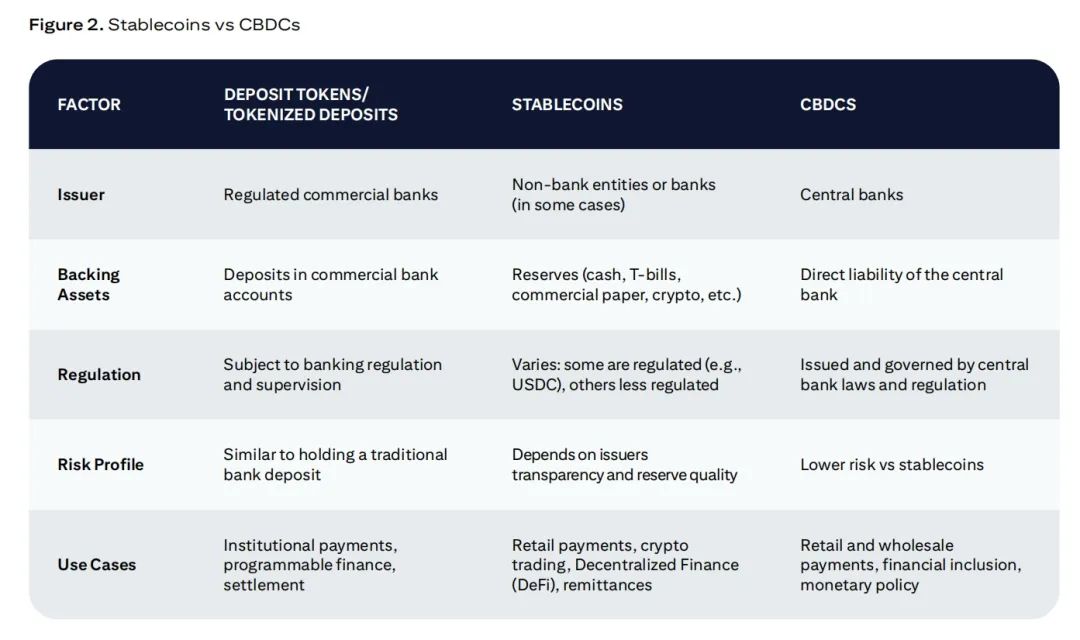
Note: Tokenized deposits are tokenized representations of commercial deposits, with each token backed by retail or institutional deposits. Deposit tokens are native tokens on the blockchain that directly represent retail or institutional deposits. So far, most banking projects can be classified as "tokenized deposits." Deposit tokens are mostly in pilot or early stages, such as the Guardian project, the Regulated Liability Network (RLN), or the Helvetia project.
1.3 Does the Public Sector Need Blockchain?
Trust and transparency are crucial for maintaining public support for governments and institutions.
Trust is the new currency for governments, and they need to build confidence and trust with citizens. Governments can continue to use centralized databases and traditional software solutions, but they may miss out on the fundamental transformations that blockchain can bring.
Saqr Ereiqa, Secretary General, Dubai Digital Asset Association
Blockchain introduces a decentralized public sector data management approach based on trust. Traditional systems derive trust from authoritative entities—such as governments verifying their own records—while blockchain allows for cryptographic proof of authenticity. Trust is rooted in the technology itself.
The immutability of blockchain ensures that once information is recorded, it cannot be altered, providing tamper-proof records for sensitive public data (such as land registries, voting systems, and financial transactions). While other technologies can also achieve immutability, they often require trusted parties to enforce it.
Cross-border activities, especially payments of international funds through institutions like the World Bank or humanitarian aid projects, are important use cases for blockchain. International fund flows can be opaque, making it difficult to effectively verify whether resources reach the intended recipients. Blockchain can provide transparency for complex transactions, even in remote or unstable areas where financial institutions may not operate effectively.
Building a blockchain when a simple database suffices is like driving a Ferrari to the corner store—expensive, inefficient, and unnecessary. If all inputs and outputs are controlled by a single entity, blockchain offers no real advantage. Its true value only becomes apparent when value exchange requires a trustless environment.
Artem Korenyuk, Digital Assets – Client, Citi
1.4 Expert Opinions
A. The Digital Trust Revolution
Siim Sikkut served as the Chief Information Officer of the Estonian government (2017-2022) and is now a member of the Estonian President's Digital Advisory Council. He is also an executive partner at Digital Nation.
Q: What prompted Estonia to adopt blockchain?
Estonia's digital transformation stemmed from real needs. As a small country with a population just over a million, efficiency and productivity are crucial. In the late 1990s, with the rise of the internet, Estonia began experimenting with digital solutions in government and banking.
These early initiatives demonstrated significant advantages, allowing the country to operate beyond its territorial and resource limitations. This success led Estonia to make a strategic commitment to digital innovation. Estonia adopted an iterative approach, testing emerging technologies to determine which were effective and promoting successful solutions. This approach birthed groundbreaking initiatives such as online voting and e-residency, both of which started as experimental projects and gradually became integral parts of Estonia's digital infrastructure. Blockchain followed a similar trajectory. Estonia adopted blockchain not to respond to a crisis but to ensure efficient digital governance.
Q: How does Estonia use blockchain in government operations? Why?
Estonia primarily uses blockchain to ensure data integrity in government systems. The key challenge is maintaining trust—ensuring that citizens can trust the security and accuracy of their data. While encryption and cybersecurity help address confidentiality and availability issues, the government needs a solution to verify the integrity of its records.
The critical question is: how to trust the system administrators and the logs they provide?
In the early 21st century, Estonia adopted a customized blockchain—KSI (Keyless Signature Infrastructure)—as an additional layer of trust. Today, it has been applied to various government databases, including the national health registry.
Notably, blockchain does not store actual records but rather records the metadata of when and by whom access or modifications to records occurred. For example, it does not store an individual's blood type but records when and by whom that entry was accessed or modified. This approach has two key advantages. First, it ensures user privacy and regulatory compliance. Second, from a cost and performance perspective, storing large datasets on-chain is impractical.
Q: What potential use cases do you see for blockchain in the future?
One promising area is digital documentation, where blockchain can enhance the security, transparency, and efficiency of welfare, grants, and public sector resource allocation. By providing an immutable ledger, blockchain can reduce fraud, strengthen accountability, and ensure seamless verification across agencies.
Another potential use is managing and safeguarding stored value, especially in government projects that allocate financial aid or subsidies. Tokenization also holds potential, particularly for government departments involved in fiscal redistribution.
B. Comprehensive Digital Policy
Julie Monaco is the Global Head of Public Sector Banking at Citibank.
Q: What does a successful national digital policy look like?
A successful national digital policy is not just about technology; it’s about vision and goals. It starts with bold leadership and a commitment to building an inclusive, human-centered digital economy. Empowering a digital czar to coordinate priorities around artificial intelligence, data privacy, and cybersecurity is key.
Strategic investments in digital identity systems are estimated to unlock access for 1.7 billion people, saving 110 billion hours of labor and increasing GDP in emerging markets by 6%. According to Juniper Research, 3.6 billion people globally are already registered, with strong momentum. Countries like Estonia, India, and Singapore demonstrate the limitless possibilities that policy-led innovation can bring.
Q: What role should blockchain play as part of a successful digital policy in achieving accountability, transparency, and efficiency?
Blockchain can absolutely play a role in successful digital policy, especially in enhancing accountability, transparency, and efficiency. It can create immutable records and automate audit trails through smart contracts, potentially reducing fraud, improving oversight, and building trust in public systems. In terms of efficiency, it can streamline services like tax collection or welfare distribution by reducing bureaucracy.
However, it is not a panacea, but if applied correctly, blockchain can be a powerful tool to help governments operate with greater integrity, responsiveness, and efficiency.
II. The GPT Moment for Stablecoins

2.1 How Do Stablecoins Work?
Stablecoins are a type of cryptocurrency designed to stabilize their value by pegging their market value to underlying assets. The underlying assets can be fiat currencies (such as the dollar), commodities (such as gold), or a basket of financial instruments.
Key components of the stablecoin ecosystem include:
Stablecoin issuers: Entities that issue stablecoins and are responsible for managing their underlying assets, typically holding value equivalent to the circulating supply of stablecoins in the underlying assets.
Blockchain ledger: Once stablecoins are issued to the public, transactions will be recorded on the blockchain ledger. This ledger provides transparency and security by tracking the ownership and flow of stablecoins among users.
Reserves and collateral: Reserves ensure that each token can be redeemed at its pegged value. For fiat-backed stablecoins, these reserves typically include cash, short-term government bonds, and other liquid assets.
Digital wallet providers: Providers of digital wallets, which can be mobile applications, hardware devices, or software interfaces, allowing stablecoin holders to store, send, and receive their currency.
How do stablecoins maintain their pegged exchange rate?
Stablecoins rely on different mechanisms to ensure their value remains aligned with the underlying assets. Fiat-backed stablecoins maintain their pegged exchange rate by ensuring that each issued token can be redeemed for an equivalent amount of fiat currency.
Major stablecoins in the market
As of April 2025, the total circulation of stablecoins has exceeded $230 billion, growing by 54% since April 2024. The top two stablecoins dominate the ecosystem, accounting for over 90% of the market share in terms of value and trading volume, with Tether (USDT) leading, followed by USD Coin (USDC).
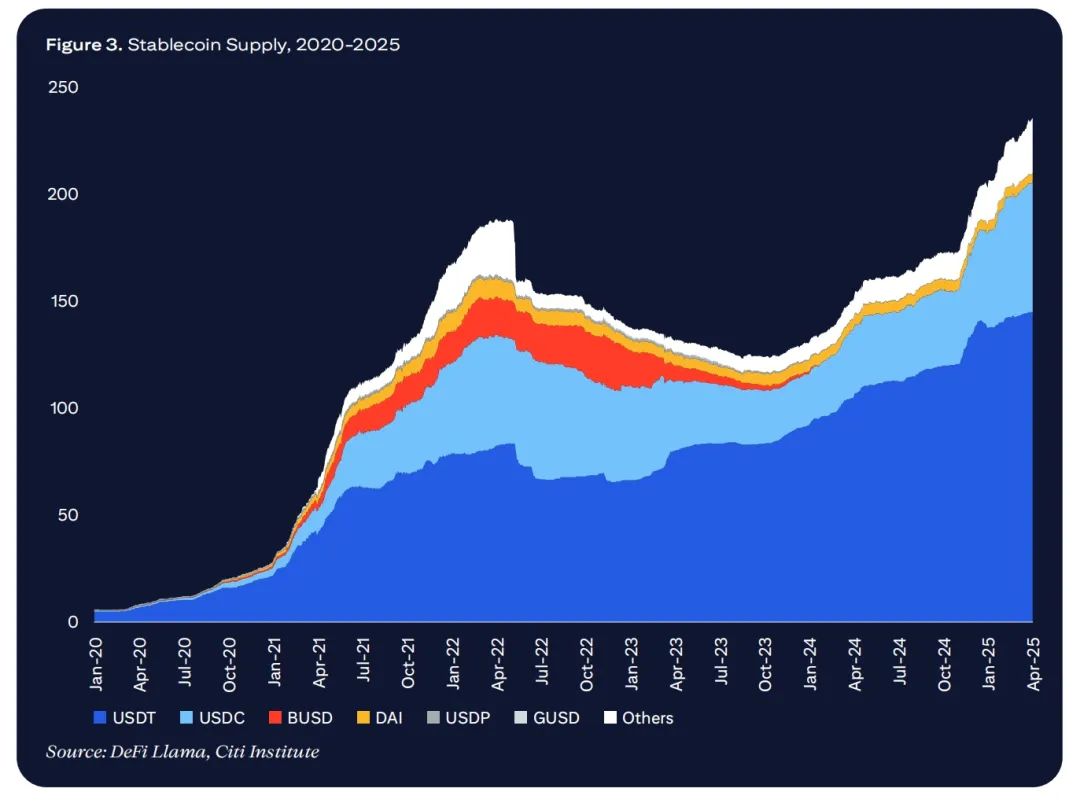
In recent years, the trading volume of stablecoins has rapidly increased. Adjusted by Visa Onchain Analytics, the trading volume of stablecoins reached $650 billion to $700 billion per month in the first quarter of 2025, approximately double the levels seen from the second half of 2021 to the first half of 2024. Trading that supports the crypto ecosystem has been a primary use case for stablecoins.
The largest stablecoin by market capitalization, USDT, was launched on the Bitcoin blockchain in 2014 and expanded to the Ethereum blockchain in 2017, enabling its use in decentralized finance (DeFi). In 2019, due to faster speeds and lower costs, USDT further expanded to the Tron network, which is widely used in Asia. USDT primarily operates overseas, but times are changing.
We will certainly see more participants (especially banks and traditional players) entering the market. Dollar-backed stablecoins will continue to dominate. Ultimately, the number of participants will depend on how many different products are needed to cover the primary use cases—and the number of participants in this market may exceed that of the credit card network market.
Matt Blumenfeld, Global And US Digital Assets Lead, PWC
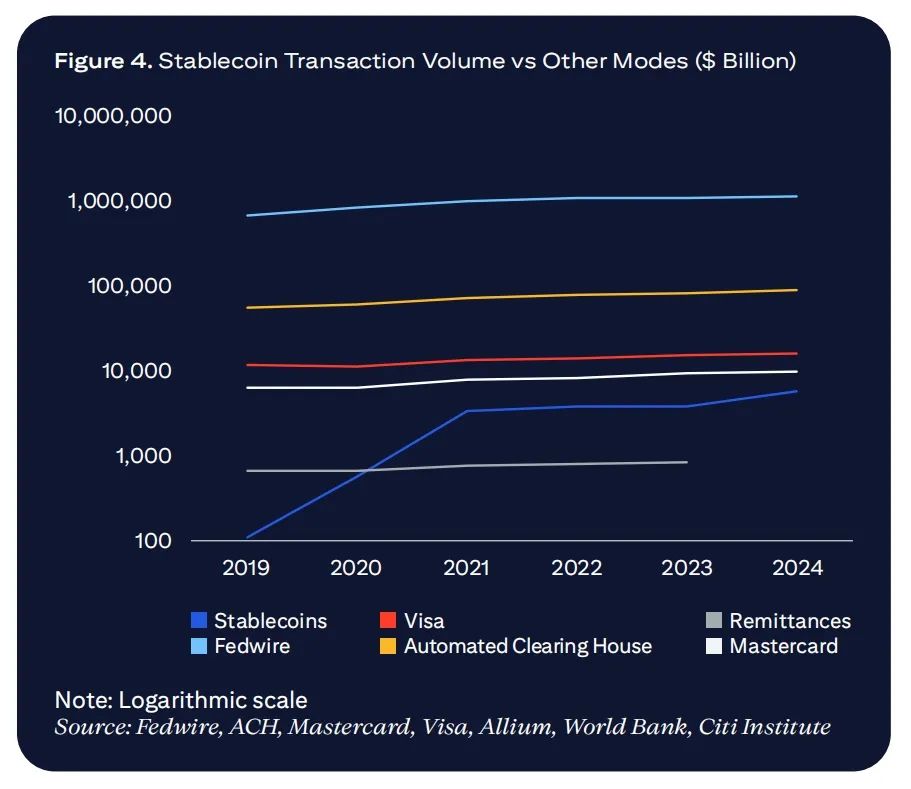
2.2 Drivers of Stablecoin Adoption
According to Erin McCune, Founder & Principal Consultant, Forte FinTech, the channel factors for stablecoins are as follows:
The practical advantages of stablecoins (speed, low cost, availability around the clock) are creating demand in both developed and emerging economies. Particularly in countries where instant payments are not yet widespread, small and medium-sized enterprises (SMBs) are not adequately served by existing businesses, while multinational companies seek to facilitate global fund transfers more easily. The costs of cross-border transactions in these countries remain high, with immature banking technology and/or lagging financial inclusion.
Macroeconomic demand (inflation hedging, financial inclusion) is driving the adoption of stablecoins in regions experiencing severe inflation. Consumers in countries like Argentina, Turkey, Nigeria, Kenya, and Venezuela use stablecoins to protect their funds. Nowadays, an increasing number of remittances are sent in the form of stablecoins, allowing consumers without bank accounts to use digital dollars.
Recognition and integration by existing banks and payment providers are key to legitimizing stablecoins (especially for institutional and corporate users) and can quickly expand their usage and applicability. Mature and scaled payment network operators and core processors can enhance transparency and facilitate integration with the digital solutions that businesses and merchants rely on. The clearing mechanisms between various stablecoins among banks and non-bank institutions are also crucial for achieving scale. Technological improvements aimed at consumers (user-friendly wallets) and merchants (embedding stablecoin acceptance into API-accessible acquiring platforms) are eliminating barriers that once kept stablecoins on the fringes of cryptocurrency.
The long-awaited regulatory clarity will allow banks and the broader financial services industry to introduce stablecoins in both retail and wholesale sectors. Transparency (audit requirements) and consistent liquidity management (reliable face value) will also simplify operational integration.
Matt Blumenfeld, Global And US Digital Assets Lead, PWC, states that the channel factors for stablecoins are as follows:
- User experience: The global payment landscape is increasingly shifting towards real-time digital transactions. However, the adoption of each new payment method faces challenges regarding customer experience—whether it is intuitive, whether use cases are visible, and whether the value is clear. Any institution that successfully enhances customer experience—whether targeting retail users or institutional users—will stand out in their respective fields and become a leader.
Integration with our current payment methods will drive the next wave of applications. In retail, this will manifest in the proliferation of debit cards or mobile wallets. In institutional contexts, this will be reflected in simpler, more flexible, and cost-effective settlements.
Regulatory clarity: Following the introduction of new stablecoin regulatory frameworks, we can see that regulatory uncertainty has severely stifled innovation and application globally. The rollout of the MiCA regulation, clarity in Hong Kong regulations, and progress in U.S. stablecoin legislation have triggered a surge in activities aimed at simplifying the flow of funds for institutions and consumers.
Innovation and efficiency: Institutions must view stablecoins as a driver for more agile product development, which is challenging in today's era. This means providing a simpler, more creative, or more attractive medium to enhance traditional bank deposits in forms such as yield generation, programmability, and composability.
2.3 Potential Market for Stablecoins
As Erin McCune of Forte Fintech points out, any predictions regarding the potential size of the stablecoin market should be made cautiously. There are numerous market volatility factors, and our own analysis indicates a wide range of market fluctuations.
We have constructed a range of forecasts based on the following factors driving the demand for stablecoins:
Converting a portion of U.S. domestic and overseas dollar holdings from cash to stablecoins—U.S. cash held overseas is often a hedge against local volatility, while stablecoins provide a more convenient way to obtain such hedges. Domestically, stablecoins can be partially used for certain payment functions and held for that purpose.
Reconfiguring a portion of the short-term liquidity held by U.S. and international households and businesses into stablecoins to support cash management and payment operations. Because stablecoins are easy to use (e.g., for cross-border payments around the clock), and if regulations allow, stablecoins may partially replace yield-bearing assets.
Additionally, we assume that the trend of substituting short-term liquidity in euros/pounds will be similar to that of dollars, with this liquidity held by domestic households and businesses, although on a much smaller scale. In the baseline scenario, we predict that by 2030, the stablecoin market will still be primarily driven by dollars (approximately 90%).
The growth of the public crypto market, where stablecoins are used as facilitators for settlement or currency acceptance; partly due to the increasing adoption of public crypto assets by institutions and the widespread use of blockchain technology. In our baseline scenario, we assume that the growth trend in stablecoin issuance from 2021 to 2024 will continue.
We estimate the baseline scenario for the stablecoin market size in 2030 to be $1.6 trillion, with an optimistic scenario estimating $3.7 trillion and a pessimistic scenario estimating $0.5 trillion.
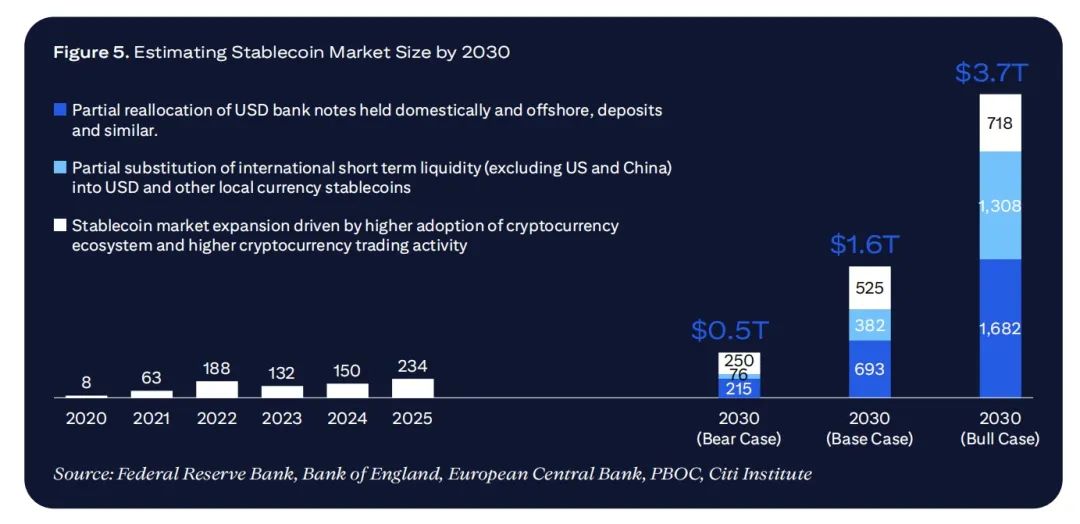
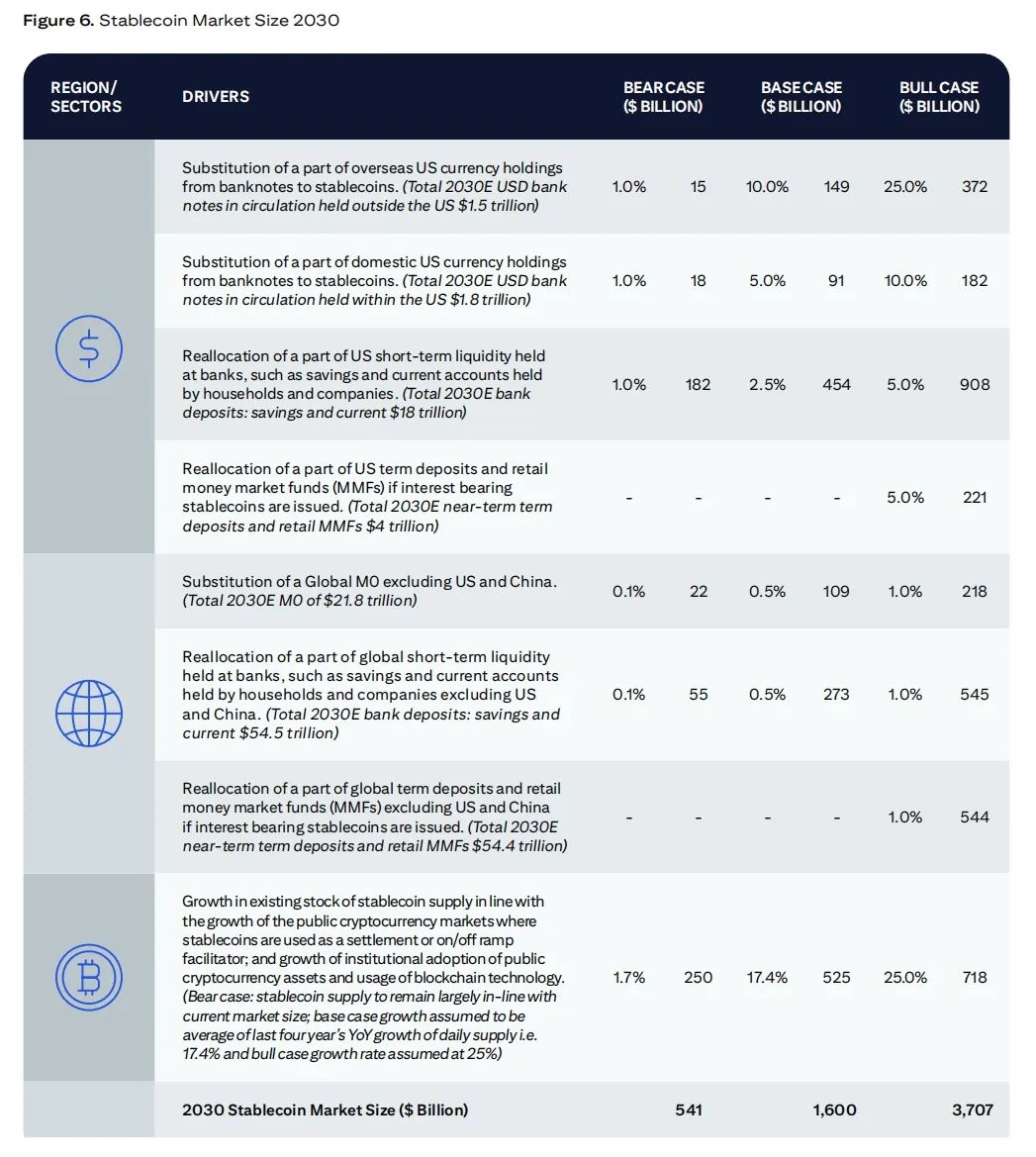
Note: The total currency supply in 2030 (circulating cash, M0, M1, and M2) is calculated using nominal GDP growth rates. The Eurozone and the UK may issue and adopt local currency stablecoins. China may adopt a sovereign central bank digital currency (CBDC), with a lower likelihood of adopting foreign privately issued stablecoins. The bearish forecast for non-dollar stablecoins in 2030: $21 billion; baseline forecast: $103 billion; bullish forecast: $298 billion.
2.4 Outlook and Use Cases for the Stablecoin Market
Erin McCune is the founder and chief consultant of Forte Fintech. She has over 25 years of consulting experience in the payments sector. Her consulting work focuses on commercial payments, cross-border transactions, and the intersection of corporate finance, banking, and enterprise software. Before founding Forte Fintech, she was a partner at Bain & Company and Glenbrook Partners.
Q: What are the optimistic and cautious outlooks for the recent stablecoin market size and the potential factors driving its development?
Predicting the growth of the global stablecoin market requires immense confidence (or hubris), as there are still many unknowns. Based on this, I present the following optimistic and pessimistic forecasts:
The most optimistic forecast is that as stablecoins become the everyday medium for global instant, low-cost, low-friction transactions, the market size will expand 5-10 times. A relatively optimistic forecast is that by 2030, the value of stablecoins will experience exponential growth from the current approximately $200 billion to $1.5 trillion - $2.0 trillion, penetrating global trade payments, P2P remittances, and mainstream banking.
This optimism relies on several key assumptions:
Regulatory policies in key regions are relaxed—not only in Europe and North America but also in markets with the highest demand for local currency alternatives, such as Sub-Saharan Africa and Latin America.
Genuine trust is established between existing banks and new entrants, as well as widespread trust among consumers and businesses regarding the integrity of stablecoin reserves (e.g., 1 dollar stablecoin = 1 dollar equivalent of priority fiat currency).
Reasonable income distribution across the entire value chain to promote collaboration; and
Widespread adoption of technologies that can connect new and old infrastructures, thereby facilitating structural efficiency and scalability. For example, merchant acquiring institutions have already begun using stablecoins. For wholesale payment applications, corporate finance and accounts payable (AP) solutions, and commercial banks will need to adjust. Commercial banks will need to deploy tokenization and smart contracts.
In a pessimistic scenario, the use of stablecoins remains limited to the crypto ecosystem and specific cross-border use cases (primarily in illiquid currency markets, which currently account for only a small portion of global GDP). Geopolitical factors, resistance to digital dollarization, and the widespread adoption of CBDCs will further hinder the growth of stablecoins. In this case, the market capitalization of stablecoins may stabilize between $300 billion and $500 billion with limited roles in the mainstream economy.
The following factors will lead to a more pessimistic scenario:
If one or more major stablecoins experience reserve failures or decoupling events, this will severely undermine the trust of retail investors and businesses.
The friction and costs associated with using stablecoins for everyday shopping are high—whether it is that remittance recipients cannot purchase groceries, pay tuition and rent, or businesses cannot easily use funds to pay salaries, inventory, etc.
Retail CBDCs have not yet gained attention, but in regions where public sector digital cash alternatives can scale, stablecoins may be less applicable.
In regions where stablecoins are increasingly scrutinized and the correlation with local fiat currencies further weakens, central bank governors may respond by tightening regulations.
If fully reserve-backed stablecoins reach a sufficient scale, this could "occupy" a large amount of safe assets to support them, potentially limiting economic credit.
Q: What are the current and future use cases for stablecoins?
Like any other payment method, the relevance and potential growth of stablecoins must be considered in the context of specific use cases. Some use cases have gained widespread attention, while others remain theoretical or clearly impractical. Here are the use cases currently (or soon) contributing to stablecoin trading volume (from largest to smallest):
Cryptocurrency Trading: Individuals and institutions using stablecoins to trade digital assets is currently the largest use case, accounting for 90% to 95% of stablecoin trading volume. This activity is largely driven by algorithmic trading and arbitrage. In a mature phase, given the ongoing growth of the crypto market and its reliance on stablecoin liquidity, trading (retail + DeFi activities) may still account for about 50% of stablecoin usage.
B2B Payments (Business Payments): According to Swift, the vast majority of traditional correspondent bank transaction amounts can reach their destination within minutes via Swift GPI. However, this mainly occurs between centralized currency banks, between liquid currencies, and during banking hours. Many inefficiencies and unpredictabilities still exist, especially when doing business in middle- to low-income countries. Companies using stablecoins to pay overseas suppliers and manage cash operations may occupy a significant share of the stablecoin market. Given that global B2B fund flows reach hundreds of trillions of dollars, even a small shift towards stablecoins could represent 20% to 25% of the total stablecoin market size in the long run.
Consumer Remittances: Despite a steady shift from cash to digital currency, regulatory pressures and the focused efforts of new entrants, remittances from overseas workers to domestic friends and family remain costly (averaging 5% for a $200 transaction: five times higher than the G20 target). With lower fees and faster speeds, stablecoins are expected to capture a significant share of the approximately $1 trillion remittance market. If the promised immediacy and significantly reduced costs are realized, stablecoins could capture 10% to 20% of the market share under high adoption rates.
Institutional Trading and Capital Markets: The use case for stablecoins in settling trades for professional investors or tokenized securities is continually expanding. Large fund flows (foreign exchange, securities settlement) could begin using stablecoins to accelerate settlement. Stablecoins can also simplify the financing process for retail purchases of stocks and bonds, which currently is often handled through bulk automated clearinghouses. Large asset management firms have begun trialing stablecoin settlements for their funds, laying the groundwork for broader applications in capital markets. Given the enormous payment flows between financial institutions, even moderate adoption could account for about 10% to 15% of the stablecoin market.
Interbank Liquidity and Funding: The proportion of banks and financial institutions using stablecoins for internal or interbank settlements is small but could have a significant impact (potentially less than 10% of the total market size). Leading industry participant JP Morgan has launched a blockchain project with daily transaction volumes exceeding $1 billion, demonstrating significant potential despite a lack of regulatory transparency. This area could see substantial growth, although it may overlap with the institutional uses mentioned above.
2.5 Stablecoins: Credit Cards, Central Bank Digital Currencies (CBDCs), and Strategic Autonomy
We believe that the usage of stablecoins may grow, creating space for new entrants. The current duopoly of issuers may persist in offshore markets, but each country's onshore market may provide a platform for new participants to join.
Just as the credit card market has evolved over the past 10 to 15 years, the stablecoin market will also change. Stablecoins share some similarities with the credit card industry or cross-border banking. All these industries exhibit strong network/platform effects and powerful reinforcing cycles. More merchants accepting a trusted brand (like Visa or Mastercard) attracts more cardholders to use that card. Stablecoins also have a similar usage cycle.
In larger jurisdictions, stablecoins are generally not subject to financial regulation, but this is changing in the EU (MICA, 2024) and the U.S. (ongoing). Stricter financial regulatory demands, along with high-cost requirements for partners, may lead to the centralization of stablecoin issuers, similar to what we see in credit card networks.
Ultimately, having a few select stablecoin issuers will benefit the broader ecosystem.
While one or two major players may seem concentrated, an excess of stablecoins can lead to fragmentation and non-fungible currency forms. Stablecoins can only thrive when they possess scale and liquidity.
Raj Dhamodharan, Executive Vice President, Blockchain & Digital Assets, Mastercard
However, the ongoing political and technological developments are leading to increased differentiation in the credit card market (especially outside the U.S.). Will the same situation occur with stablecoins?
Many countries have developed their national card schemes, such as Brazil's Elo (2011) and India's RuPay (2012). The launch of many national card schemes is driven by considerations of national sovereignty and is influenced by local regulatory changes and political encouragement from domestic financial institutions. They have also integrated with new national real-time payment systems, such as Brazil's Pix and India's UPI. While international card schemes have continued to grow in recent years, they have lost market share in many non-U.S. markets. In many markets, technological changes have led to the rise of digital wallets, account-to-account payments, and super apps. All of this has contributed to a decline in credit card market share.
Just as we have seen a surge in national-level programs in the credit card market, we are likely to see jurisdictions outside the U.S. continue to focus on developing their central bank digital currencies (CBDCs) as tools for national strategic autonomy, especially in the wholesale and corporate payments sectors.
A survey by OMFIF of 34 central banks shows that 75% of central banks still plan to issue CBDCs. The proportion of respondents planning to issue CBDCs in the next three to five years has increased from 26% in 2023 to 34% in 2024. Meanwhile, some practical implementation issues are becoming increasingly prominent—31% of central banks have delayed their issuance timelines, citing legislative concerns and a desire to explore broader solutions.
CBDC projects began in 2014 when the People's Bank of China (PBoC) started researching the digital yuan. Coincidentally, Tether was also born in that year. In recent years, stablecoins have developed rapidly under the influence of private market forces.
In contrast, CBDCs largely remain in the official pilot stage. A few small economies that have launched national-level CBDC projects have not seen much natural user growth. However, the recent escalation of geopolitical tensions may increase interest in CBDC projects.
2.6 Stablecoins and Banks: Opportunities and Risks
The adoption of stablecoins and digital assets presents new business opportunities for some banks and financial institutions to drive revenue growth:
The Role of Banks in the Stablecoin Ecosystem
Banks have many opportunities to participate in the development of stablecoins, continuing to act as hubs for currency flow. This can be as direct stablecoin issuers or as part of payment receipt/payment solutions, structured products around stablecoins, general liquidity provision, or playing a more indirect role.
As users seek more attractive products and better experiences, we have seen deposits flowing out of the banking system. With stablecoin technology, banks have the opportunity to create better products and experiences while keeping deposits within the banking system—users generally prefer their deposits to be secured within the banking system.
Matt Blumenfeld, Global and US Digital Assets Lead, PwC
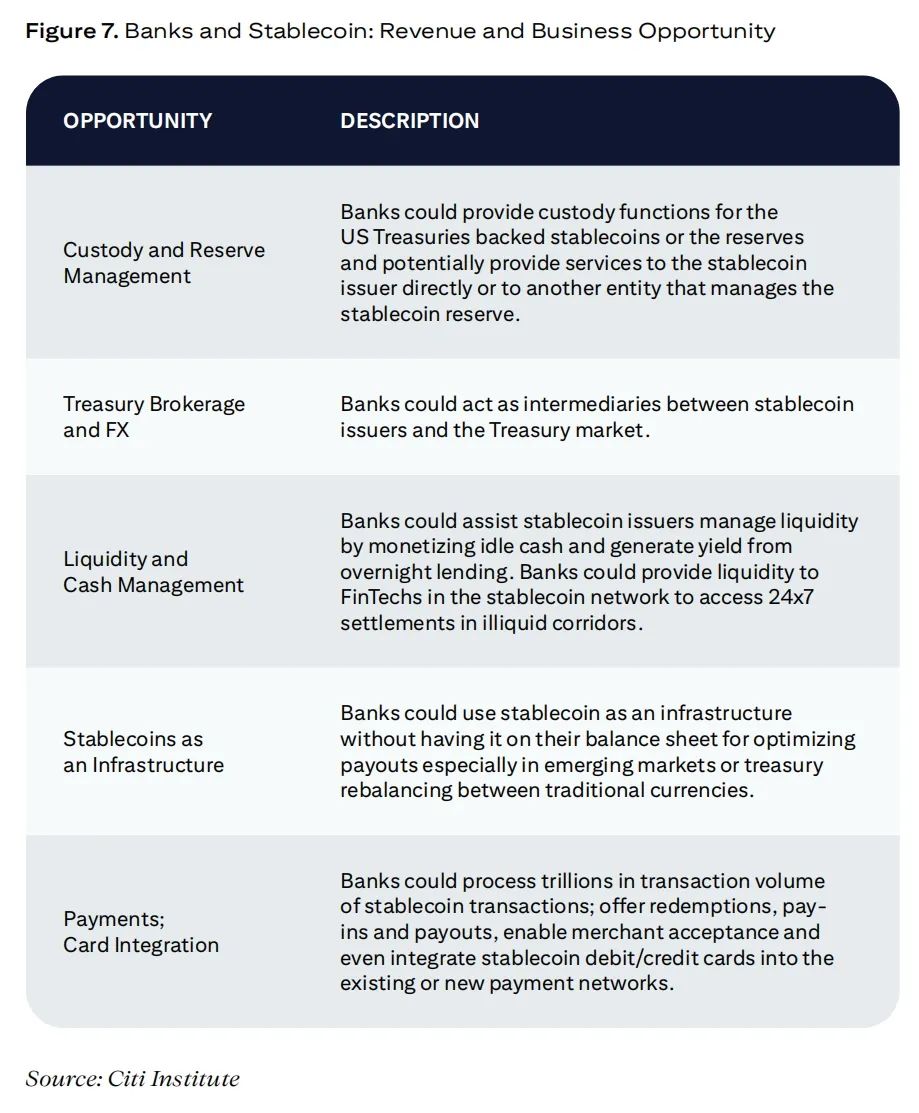
At the system level, stablecoins may have effects similar to "narrow banking," and the policy debates surrounding such institutions have been longstanding. The shift of bank deposits to stablecoins could impact banks' lending capacity. This decline in lending capacity may suppress economic growth, at least during the transition period of system adjustment.
As summarized in the International Monetary Fund's 2001 Paper No. 9, traditional economic policy opposes narrow banking due to concerns about credit creation and growth. The Cato Institute's 2023 report and similar institutions have also raised objections, arguing that "narrow banking" can reduce systemic risk while credit and other liquidity will adapt.
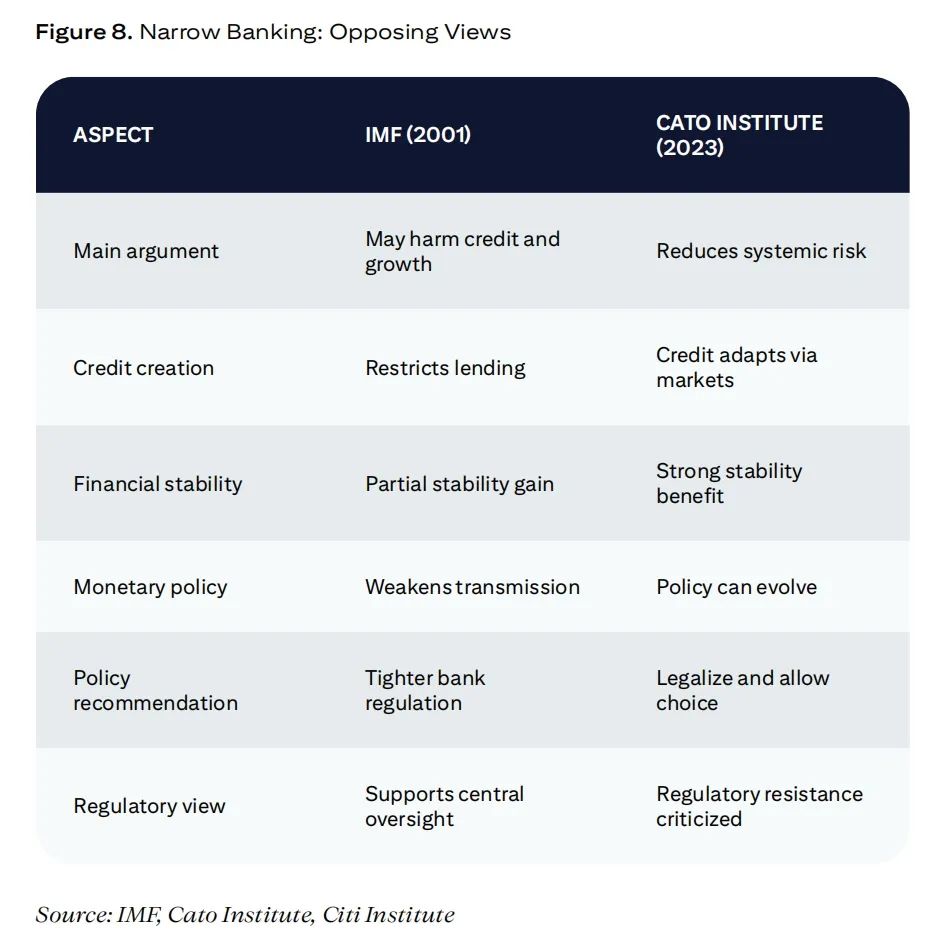
### 3. The Public Sector's Perspective on Blockchain

Trust and transparency are the core advantages of blockchain in the public sector. Blockchain has tremendous potential to replace existing centralized systems, thereby improving operational efficiency, enhancing data protection, and reducing fraud.
While the on-chain transaction volume in the public sector may initially be smaller than in the private sector, the growing interest from the public sector is crucial for the widespread application of blockchain.
3.1 Public Spending and Finance
Blockchain technology is expected to transform public spending and finance in government services by improving transparency, efficiency, and accountability while significantly reducing reliance on manual and paper-based processes. By integrating financial and non-financial reporting between government agencies and external partners, blockchain can track spending in real-time.
This should help reduce the risk of corruption while enhancing public trust in public institutions. The immutable nature of blockchain records ensures the traceability and verifiability of transactions, thereby simplifying audit processes and strengthening accountability. Blockchain can also monitor fiscal allocations in real-time and provide data-driven insights to assess the impact of public spending.
The use of smart contracts can enhance the efficiency of the bidding process by automating the bidding, evaluation, and contract awarding processes. This reduces human intervention and increases the transparency of contract awards, addressing common biases and favoritism in manual selection. Contract payments can also be phased based on milestones, ensuring that funds are only released when project milestones are achieved.
By integrating blockchain into accounting systems, tax collection and compliance processes can be streamlined, automating tax calculations and remitting to the government. Since all transactions are permanently recorded on the blockchain, tax evasion becomes more difficult, thereby strengthening tax administration.
Blockchain-based digital bonds can also facilitate faster and more transparent issuance through automatic interest payments. It allows for fractional ownership, thereby expanding investor participation. Real-time tracking of debt instruments throughout the bond's term can further enhance accountability and investor confidence.
In addition to improving efficiency and accountability, the digitization of government services based on blockchain can significantly reduce the vast amounts of paper documents generated annually for contracts, records, and transactions. For example, Dubai's "Paperless Strategy" aims to reduce billions of sheets of paper generated each year by digitizing all services (including visa applications, bill payments, and license renewals), which will now be securely transacted using blockchain technology.
3.2 Disbursement of Public Sector Funds and Grants
Traditional government and public sector funding and grant disbursement processes often involve a significant amount of manual work—processing forms, verifying claims, and managing cash flow. Blockchain offers a more efficient alternative that can streamline processes while enhancing data security and integrity. Using blockchain can also improve transparency, ensuring fair distribution of funds and reducing opportunities for corruption and fraud. Additionally, blockchain can lower operational costs and improve the efficiency of record-keeping and reconciliation.
Cryptographic hash data is integrated into the blockchain system to enhance the integrity of transaction information and prevent unauthorized access. Smart contracts can also automate and secure the disbursement process by programming predefined conditions (such as verifying eligibility criteria).
Blockchain technology is well-suited for cross-border use in many ways, with the World Bank's "FundsChain" initiative launched in September 2024 being a prime example. This initiative currently has nine projects underway in Moldova, the Philippines, Kenya, Bangladesh, Mauritius, and Mozambique.
FundsChain—The World Bank's Blockchain for Tracking Fund Disbursement
The World Bank is responsible for disbursing billions of dollars annually and ensuring that funds are used for their intended purposes. Given the numerous projects across multiple countries, tracking and verifying the use of funds has traditionally been a time-consuming manual process. While some tasks have been automated, much of the regulatory work still requires significant labor. The FundsChain initiative aims to improve the transparency and efficiency of the fund allocation process.
The World Bank has partnered with Ernst & Young to develop a blockchain-based platform designed to track the flow and expenditure of funds in real-time. FundsChain provides robust fund disbursement tracking capabilities, allowing stakeholders to view fund flows in real-time, enhancing transparency and building confidence that funds truly reach the intended beneficiaries, ultimately enabling the World Bank to support the anti-corruption reform agendas of borrowing countries.
Tokens are generated when funds are credited. These tokens are recorded in the digital wallets of each entity. The automation of transactions through smart contracts enhances efficiency; by storing and notarizing uploaded resources on the blockchain, security and data integrity are further improved. Consensus algorithms are used to verify transactions and prevent overspending.
Currently, this oversight is achieved by contractually requiring borrowers to submit expenditure reports and collect other supporting documents. This can be a highly manual, labor-intensive, and time-consuming process that requires significant coordination, time, and costs. Through FundsChain, all project stakeholders (including borrowers, suppliers, auditors, and ultimate beneficiaries) can see where funds are going, how they are being used, and when, achieving end-to-end transparency, with all transactions recorded on-chain, allowing stakeholders to monitor fund flows in real-time.
The World Bank uses a private blockchain to build FundsChain because they want to maintain control over the platform and its future development. Given the sensitivity of its public sector mission, they do not wish to rely on third-party vendors. They also want to ensure that any platform they use can interoperate with those of other multilateral development banks for seamless integration.
3.3 Public Record Management
Blockchain technology provides a powerful and secure platform for public record management, ensuring the authenticity, integrity, and accessibility of critical data. By leveraging an immutable ledger, blockchain can maintain the integrity, accuracy, and tamper-proof nature of records, thereby enhancing public trust in government systems.
Unlike traditional databases that store records centrally, data on the blockchain is distributed across a network of multiple nodes, ensuring that data remains accessible even if a single node fails, and reducing the risk of data breaches from network attacks. Any modifications to records are encrypted and timestamped, creating an auditable trail that enhances accountability while protecting citizen data. Blockchain also improves the accessibility and availability of records, as they can be easily retrieved and accessed when needed.
Governments around the world are exploring blockchain solutions for public record management. For example, Singapore's OpenCerts is a blockchain platform that enables educational institutions to issue and verify tamper-proof academic certificates. This helps reduce the risk of document forgery and simplifies credential verification.
Another area where blockchain can drive significant improvements is land ownership and real estate management. This sector is often plagued by fragmented record-keeping, outdated processes, and corruption. In countries where public sector corruption is rampant, the risk of fraud is particularly high. For instance, Georgia has integrated its land ownership registration system into the Bitcoin blockchain, improving the verification of real estate-related transactions while enhancing security and service efficiency.
In countries with weak institutional integrity, there is an opportunity to enhance transparency through decentralized ledgers and restore public trust in public institutions. These ledgers are auditable, transparent to the public, and maintained by various parties, each with non-collusive incentives.
Artem Korenyuk, Digital Assets – Client, Citi
3.4 Humanitarian Aid
Effective coordination is crucial during crises, as multiple entities use different systems to provide food, healthcare, and shelter assistance. Blockchain can simplify project design, resource allocation, and data sharing by providing a unified shared ledger, avoiding duplication of efforts and ensuring that aid reaches those who need it most. Real-time, verifiable transaction records can also facilitate collaboration between aid agencies, governments, and NGOs, thereby shortening overall response times.
In addition to coordination, blockchain has the potential to reshape crisis crowdfunding by providing a transparent and decentralized mechanism for mobilizing funds. By leveraging digital currencies, blockchain can collect donations and transfer them directly to verified beneficiaries without intermediaries, reducing costs and delays. The use of smart contracts can further automate fund disbursement based on predetermined conditions.
Ensuring the integrity of humanitarian supply chains is another key challenge that blockchain may help address. By enabling end-to-end traceability, blockchain allows aid organizations to track the origin, movement, and usage of humanitarian supplies. This breaks down data silos, prevents corruption, and ensures that aid supplies are delivered effectively to affected communities. It can also enable real-time inventory tracking, helping organizations respond more quickly to shortages and avoid logistical bottlenecks.
The United Nations High Commissioner for Refugees (UNHCR) uses the Stellar blockchain to distribute humanitarian aid, which is a compelling example of blockchain's impact in the public sector. UNHCR implements blockchain technology to streamline the disbursement process of financial assistance and has successfully applied it in Ukraine, Argentina, and other parts of the world. A key advantage of blockchain is the significant cost savings achieved through overall digital transformation efforts.
Blockchain also brings greater transparency. In many crisis situations, displaced individuals may lack access to traditional banking services. By using blockchain-based wallets, aid recipients can receive and use funds without relying on intermediaries.
Denelle Dixon, CEO and Executive Director, Stellar Development Foundation
3.5 Asset Tokenization
Tokenization is expected to unlock value by digitally representing real-world and financial assets through tokens, enhancing efficiency, transparency, and accessibility. In the public sector, tokenization can be applied to both financial and physical assets.
Governments can tokenize debt instruments to improve the efficiency of bond issuance and allow a broader range of investors to participate. Similarly, natural resources and infrastructure assets (such as roads, bridges, and utilities) can be represented in the form of digital tokens, enabling more efficient tracking, management, and financing.
In addition to investment accessibility and fractional ownership models, tokenization can help financial institutions and public entities streamline operations, reducing inefficiencies and systemic risks. Automation through smart contracts can minimize intermediaries, enhance liquidity, and build public trust in the management of public assets.
Some institutions have already explored the application of blockchain in digital bonds. For example, the European Investment Bank (EIB) issued its first blockchain-based digital bond worth €100 million in 2021. This issuance was done in collaboration with a French bank, using blockchain for the registration and settlement of digital bonds.
In 2022, the European Investment Bank launched the Venus project, issuing its first euro-denominated digital bond on a private blockchain using central bank money in the form of wholesale CBDC. Similarly, the city of Lugano in Switzerland completed three bond issuances between 2023 and 2024 using the Swiss National Bank's wholesale CBDC, leveraging distributed ledger technology (DLT)/blockchain technology.
Promissa – Tokenized Promissory Notes
Many international financial institutions, including multilateral development banks (MDBs), derive part of their funding from financial instruments known as promissory notes, most of which still exist in paper form. While the current system framework provides operational control for member countries to pay subscriptions and fees to public institutions like the World Bank, the custody of unpaid promissory notes can be digitized to address operational challenges and further enhance efficiency.
The Promissa project, initiated by the Bank for International Settlements Innovation Hub, the Swiss National Bank, and the World Bank, aims to build a prototype platform for digitally tokenized promissory notes. The Promissa project explores the use of distributed ledger technology (DLT) to simplify promissory note management and provide a single source of truth for all counterparties throughout the lifecycle of the promissory notes. This will enable central banks of member countries to have a comprehensive understanding of their outstanding notes with multilateral development banks, and vice versa.
The number of promissory notes among multilateral development banks is vast: for example, the two largest institutions of the World Bank—the International Bank for Reconstruction and Development (IBRD) and the International Development Association (IDA)—have a significant number of promissory notes committed by member countries since their inception. While the Project Promissa aims to reimagine a "single source of truth" platform solution to simplify the management of promissory notes between member countries and multilateral development banks, it could be extended in the future to payments related to such promissory notes through the integration of tokenization or existing payment systems.
3.6 Digital Identity
A single digital identity can serve as an effective proof for public and private transactions, enhancing storage security and convenience. Blockchain-based digital identity (ID) provides a decentralized, tamper-proof identity verification mechanism, thereby reducing the risks of fraud and identity theft.
Digital identity extends basic services to underserved communities and those without official documentation, such as displaced persons. With nearly 850 million people lacking official identification, digital IDs can empower individuals by using alternative data such as biometrics and community verification.
The immutable nature of blockchain creates transparent records for each transaction, establishing verifiable digital audit trails that enhance security and accountability. Its decentralized architecture and robust encryption protocols protect personal data from breaches and fraud.
Moreover, self-sovereign identity ensures that individuals have ownership and control over their information, selectively sharing data as needed. Advanced technologies like zero-knowledge proofs can verify identity attributes without disclosing sensitive information.
The city of Zug in Switzerland is an early example, offering residents a single, verifiable electronic identity based on the Ethereum blockchain for various applications. The blockchain digital identity project in Zug was launched in 2017, but its application has been limited so far due to a range of factors, including complexity and limited availability.
In 2023, Brazil launched a new national ID based on blockchain. The new digital ID can be accessed via mobile devices using facial recognition and QR codes. These IDs are stored on a private blockchain called b-Cadastros, built by a Brazilian state-owned IT service company, aimed at enhancing the security and reliability of data sharing among public institutions.
3.7 Challenges Facing Blockchain Applications in the Public Sector
Blockchain holds tremendous potential for government services, offering numerous advantages such as transparency, security, and efficiency. However, the large-scale application of blockchain also faces significant challenges as described below.
Establishing standardized protocols and practices will help public blockchains gain broader recognition and trust in banking and government. Promoting collaboration between the public and private sectors can drive innovation and ensure that blockchain solutions meet the needs of all stakeholders.
Ricardo Correia, Partner, Bain & Company
Lack of Trust: Many blockchain solutions are still in experimental stages and untested, making it difficult to build trust within the ecosystem. There is a need to raise awareness across the ecosystem and cultivate relevant skills. This requires time and investment.
Interoperability and Scalability: For blockchain solutions to be adopted nationally or globally, they need to be interoperable and scalable to handle large volumes of transactions. Efforts are currently underway to establish global standards for blockchain to gain widespread recognition across different markets.
Transformation Challenges: Overhauling existing infrastructure can be highly challenging, requiring significant time and resources. Insufficient evidence of actual benefits, perceptions of blockchain technology as immature, and the presence of complex legacy systems further hinder new investments.
Regulatory Issues: The decentralized nature of blockchain presents challenges for large-scale applications, necessitating the establishment of regulatory frameworks to recognize the legal nature of blockchain, the validity of stored documents, and the financial instruments issued. Ambiguity in regulation slows down the adoption of blockchain.
Addressing Abuse Risks: While it is difficult to quantify the scale of illegal cryptocurrency use, it is estimated that illegal addresses received $51 billion in cryptocurrency in 2024, an 11% increase from the previous year. However, as a percentage of total on-chain transaction volume, this figure is typically less than 1%.
Resistance to Change and Public Perception
Implementing blockchain often means a complete overhaul of existing systems, which can change every aspect of public officials' work, including their daily tasks. While some may view blockchain as a positive change to improve administrative processes, many tend to resist it, perceiving blockchain as a threat.
Public perception also plays a crucial role. Blockchain is sometimes associated with speculative cryptocurrency markets and meme coins, overshadowing the advantages of its underlying technology in the real world. This may exacerbate skepticism, slowing its mainstream application in the public sector.
Saqr Ereiqat, Secretary General, Dubai Digital Asset Association
### Appendix

4.1 Stablecoin Regulation: GENIUS Act and STABLE Act
This section focuses on two major stablecoin legislations currently under consideration by the U.S. Congress. Both pieces of legislation aim to establish a regulatory framework that integrates stablecoins into the mainstream financial ecosystem.
The "Guiding and Establishing the National Innovation of U.S. Stablecoins Act" (GENIUS Act) proposes a dual regulatory approach based on the market capitalization level of stablecoin issuers.
Stablecoin issuers with a total market capitalization below $10 billion can opt to be regulated by state-level regulatory agencies (if the state regulatory framework is substantially similar to the federal regulatory framework). Issuers exceeding the $10 billion threshold will be subject to federal regulation. Both banks and non-bank entities can issue stablecoins with regulatory approval.
The bill outlines the obligations of issuers, including 1:1 reserve backing, disclosure and redemption procedures, monthly reserve composition reports and attestations, prudential standards, and a range of consumer protection measures.
The second piece of legislation is the "2025 Stablecoin Transparency and Accountability to Promote Better Ledger Economy Act" (STABLE Act). This bill shares many similarities with the GENIUS Act regarding the types of companies allowed to issue stablecoins and has similar requirements for issuers to maintain 1:1 reserves (though differing in reserve composition), as well as similar requirements for information disclosure and monthly attestations. Unlike the GENIUS Act, this bill does not distinguish issuers based on a $10 billion market threshold.
Given that these bills will empower certain stablecoin issuers to opt into state-level regulatory frameworks, they may create regulatory arbitrage risks, where some states might introduce less stringent regimes to attract stablecoin issuers. Differences in state-level regulatory frameworks may make it difficult for banks to do business with issuers subject to various regulatory regimes.
While both bills open the door for banks to provide stablecoin payment services, including offering custodial services, private keys, or reserve backing for stablecoins, ensuring that the legislation provides appropriate protections against illicit financing will be key for banks to fully capitalize on such opportunities.
Both bills will take effect 18 months after enactment (exact date to be determined) or 120 days after federal banking regulators issue final implementing regulations, whichever comes first. Both bills must go through a reconciliation process, with the House and Senate voting on the same version of the legislation before they can become law. During this process, the bills may still undergo substantive changes.
4.2 Public Chain vs. Private Chain
When exploring blockchain-based infrastructure, it is essential to weigh the pros and cons of private chains versus public chains. Public chains are permissionless networks that allow anyone to participate, validate transactions, and access data. This openness makes them a powerful tool for achieving accessibility and transparency, but it also presents challenges in areas such as regulatory enforcement and scalability.
This is similar to the current state of public cloud computing and hosting. Banks and financial institution regulators have previously expressed concerns about the security and control of data stored in public clouds. Similarly, there are concerns regarding public chains. Banks need to implement appropriate controls and risk mitigation measures, develop rulebooks, and provide relevant education on this matter.
Biser Dimitrov, Digital Assets – Technology, Citi
Decentralized and free from any authority: Public chains often operate independently of any single entity, reducing the risk of government overreach, censorship, or unilateral manipulation. Governance is typically decentralized, achieved through consensus mechanisms such as Proof of Work (PoW) or Proof of Stake (PoS).
Transparency and Auditability: Public chains ensure that transactions are permanently recorded and publicly accessible. This transparency enhances accountability, reduces corruption, and helps build trust in the financial system.
Interoperability and Open Accessibility: Stablecoins issued on public chains can be used across various applications and services without the need for custom integration. They also promote global accessibility, allowing anyone with an internet connection to access and use them.
Security and Resilience: The decentralized nature of public chains, protected by a vast network of nodes and cryptographic mechanisms, makes them more resilient to single points of failure, network attacks, and centralized assaults compared to private systems.
On the other hand, public chains may not be suitable for all use cases:
Scalability and Transaction Throughput: Public chains may face challenges in transaction throughput, especially when handling large volumes of transactions, leading to slower processing speeds and higher fees. This makes them less suitable for handling high-volume, real-time financial transactions.
Lack of Privacy and Anonymity: Since all transactions are publicly visible, public chains may not be ideal for processing sensitive financial or other government data. Anonymity may vary depending on the type of blockchain.
Regulatory Compliance Challenges: The anonymity of public chains complicates the enforcement of Anti-Money Laundering (AML) and Know Your Customer (KYC) regulations. Governments may find it difficult to track illegal financial activities or effectively enforce financial policies.
Limited Customization: While stablecoins issued on public chains provide a mature framework, they have limited flexibility for customizing solutions for specific use cases.
Policymakers and risk managers may also need to consider other issues: (1) uptime and reliability, and (2) identifying the most trustworthy tokens associated with public chains. For some, this relates to negative perceptions of cryptocurrencies (as they were initially associated with illegal activities).
Whether in the private or public sector, banks and large institutions have traditionally relied on proprietary, internally deployed technologies. Open-source and cloud technologies take time to penetrate these institutions. The integration of public chains and permissionless blockchains will be a challenge—but with support from regulatory and policy changes, transformation is underway.
免责声明:本文章仅代表作者个人观点,不代表本平台的立场和观点。本文章仅供信息分享,不构成对任何人的任何投资建议。用户与作者之间的任何争议,与本平台无关。如网页中刊载的文章或图片涉及侵权,请提供相关的权利证明和身份证明发送邮件到support@aicoin.com,本平台相关工作人员将会进行核查。




